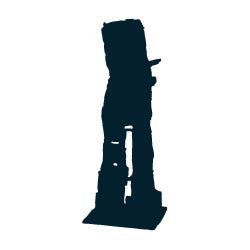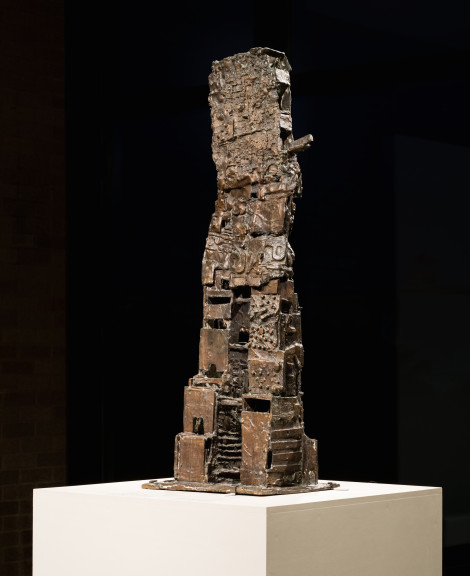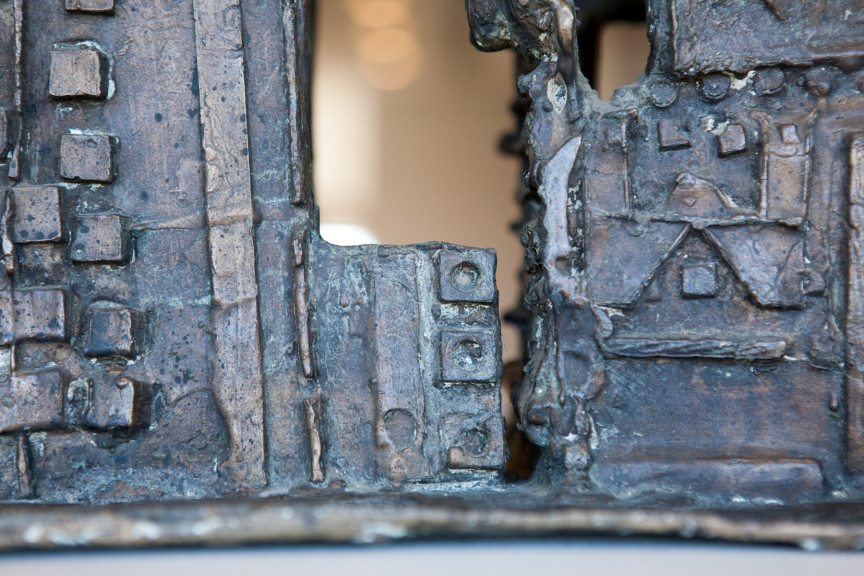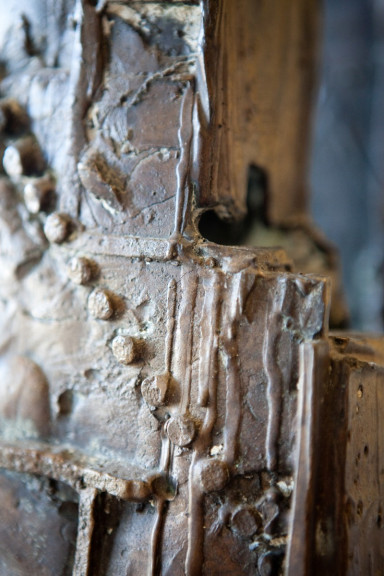Figure
Eduardo Paolozzi
36 1/4 × 12 3/8 × 10 1/2 inches
Photography not permitted
Lent by The Metropolitan Museum of Art
Gift of Margaret H. Cook, 1996
1996.439
GPS: 30.285811,-97.731131
Like Bernard Meadows (1915–2005), Eduardo Paolozzi was deeply affected by the politics and circumstances of World War II. Before the war, he studied at London’s Slade School of Art, where he absorbed the ideas of Surrealist artists and writers. Advances in technology and the mechanization of cultural production preoccupied Paolozzi. He began to express these issues through collage, a technique favored by Dada and Surrealist artists for its ability to provoke both intellectual and psychological responses. Shortly after the war, Paolozzi made a series of collages combining pictures of classical sculptures with images of modern machines. The works are an expression of the turmoil caused by the old European order colliding with the new technological world.
One of Paolozzi’s significant innovations was translating the aesthetic of collage into sculpture. In Figure and related works from the 1950s, he gathered discarded machine parts and technological components, pressing them into slabs of wax. After casting these in bronze, he stacked the pieces atop one another and welded them together into semiabstract, robot-like figures. With their uncanny, futuristic appearances, Paolozzi’s figures seem at once recognizable and unfamiliar.
Paolozzi’s sculptures relate to the emergence of cybernetics in the arts, literature, philosophy, and science. The idea of automata (humanlike machines) had appeared in science fiction in tandem with the increasing use of machines during the Industrial Revolution of the nineteenth century. In stories, robots were often viewed as ominous: anthropomorphic yet inhuman; intelligent yet soulless; an uncontrollable threat to human supremacy. After World War II, scientists began publishing accounts of efforts to merge electronics with human capabilities, making the robots of science fiction seem feasible. Combining humanoid appendages and machined parts, Paolozzi’s bionic Figure appears like a prototype for a future cyborg.
ACTIVITY GUIDES

Figure
Eduardo Paolozzi
Subject: Making a collage by juxtaposing elements
Activity: Create a collage robot
Materials: Magazines, catalogs, etc., along with paper, glue, and scissors
Vocabulary: casting, collage, juxtaposition, semiabstract
Edward Paolozzi was deeply affected by World War II. Shortly after the war, he made a series of collages combining pictures of classical sculptures with images of modern machines. The juxtaposition of these images suggested how the old European order was colliding with the new technological world.
During the mid-1950s, Paolozzi created a series of figure sculptures representing a standing human as a mixture of mechanical parts. He gathered old machine parts and cast-off technology components, which he pressed into slabs of wax. After casting them into bronze, Paolozzi welded the pieces together into semiabstract figures that resembled robots. Paolozzi’s robotoid sculptures have ravaged surfaces and appear damaged, as if they are war survivors.
What associations do you make when you think of robots? Why do you think Paolozzi decided to make robots?
What do you think about Paolozzi’s method of making this sculpture? Why do you think he chose this method?
How would figures representing war look different today? How has warfare changed?
Cut out pictures from magazines, catalogs, or books to create your own “robot” figure. Use a variety of images of both manmade objects and from nature. Try to juxtapose different kinds of images. Think about what your robot represents.
Cybernetics and the possibility of actual robots came to public awareness after World War II, when the scientist Norbert Wiener published Cybernetics (1948). This account of efforts to merge electronics with human capabilities made the robots of science fiction seem possible.
Like Bernard Meadows, Paolozzi responded to World War II in his sculptures. Compare Meadows’s Augustus with Paolozzi’s Figure. How are they constructed similarly? Differently? What do you think the sculptures are saying about war? Which sculpture do you think is a darker representation of war or a more successful one?
Casting - a method of producing one or more copies of a sculpture. Typically, the original sculpture is covered with a molding material that sets hard when dry. The mold is then separated to release the original sculpture. Once the mold is reassembled, the casting material is poured into the void and left to set. Traditionally, molten bronze is used as the casting material. When the cast sculpture has cooled, or cured, the mold is again separated to release it and reassembled to cast the next copy.
Collage - a work of art made by pasting various materials, such as bits of paper, cloth, etc., onto a piece of paper, board, or canvas
Juxtaposition - the act of placing two or more things side by side
Semiabstract - having subject matter that is easily recognizable although the form is not realistic
MORE INFORMATION
Like Bernard Meadows, Edward Paolozzi was deeply affected by the politics and realities of World War II. Earlier, he had studied at the Slade School of Art and was much impressed by the ideas of surrealism. He worked primarily in collage—a favorite of Dada and surrealist artists because disparate images could be juxtaposed to provoke an intellectual or psychological reaction.
Shortly after the war, Paolozzi made a series of collages combining pictures of classical sculptures with images of modern machines, as an expression of the turmoil caused by the old European order colliding with the new technological world. Paolozzi was profoundly impressed by this idea as presented by the American historian Lewis Mumford in his books Technics and Civilization (1934) and The Condition of Man (1944).
Figure, 1957
During the mid-1950s, Paolozzi created a series of figure sculptures representing a standing human as a conglomeration of mechanical parts. Applying the methodology of collage to sculpture, he gathered old machine parts and cast-off technology components, which he pressed into slabs of wax. After casting them into bronze, Paolozzi welded the pieces together into semiabstract figures.
These sculptures relate to the emergence of cybernetics in the arts, literature, philosophy, and science. The idea of automata (humanlike machines) had appeared in science fiction, in tandem with the increasing use of machines during the Industrial Revolution of the nineteenth century. Cybernetics and the possibility of actual robots came to public awareness after World War II, when the scientist Norbert Wiener published Cybernetics (1948). This account of efforts to merge electronics with human capabilities made the robots of science fiction seem feasible.
In stories by Isaac Asimov, Ray Bradbury, and others, and especially in movies, robots were usually viewed as ominous: anthropomorphic yet inhuman, intelligent yet soulless, threatening and uncontrollable, a threat to human supremacy. Only rarely were they portrayed as a sympathetic machine seeking to become more human. Today’s computer-dominated society may consider the robots of popular culture in the 1950s and 1960s as naïve and camp, but those years were pervaded by the fears and anxieties of the Cold War with its ever-present possibility of nuclear annihilation.
Paolozzi’s robotoid sculptures have irregular contours and seemingly ravaged surfaces. They appear damaged, as if survivors of a holocaust. Figure lacks both arms and head, and its clumsy legs and feet appear heavy and difficult to move. The suggestion of a small step forward may be an ironic art historical allusion to the damaged anatomy of Auguste Rodin’s Walking Man of 1899–1905 and Alberto Giacometti’s Walking Man sculptures of 1946–48.
Valerie Fletcher is Senior Curator at the Hirshhorn Museum in Washington, DC. Her research on groundbreaking aspects of international, globalized, and transnational art have resulted in numerous exhibitions and publications.
Ades, Dawn, et al. Lost Magic Kingdoms and Six Paper Moons from Nahuatl: An Exhibition at the Museum of Mankind. London: British Museum, 1985.
Ballard, J. G., and Frank Whitford. “Speculative Illustrations.” [interview] Studio International 183 (October 1971): 136–43.
Kirkpatrick, Diane. Eduardo Paolozzi. Greenwich, CT: New York Graphic Society, 1970.
Paolozzi, Eduardo, and Frank Whitford. Eduardo Paolozzi: Private Vision-Public Art. London: Architectural Association, 1984.
Pearson, Fiona. Paolozzi. Edinburgh: National Galleries of Scotland, 1999.
Reichardt, Jasia. “Eduardo Paolozzi.” Studio International 168 (October 1964): 152–57.
Rodoti, Edouard. “Interview with Eduardo Paolozzi.” Arts Magazine 33 (May 1959): 42–47.
Spencer, Robin, ed. Eduardo Paolozzi: Writings and Interviews. Oxford: Oxford University Press, 2000.
Tate Gallery. Eduardo Paolozzi. London, 1971. Texts by Sir Norman Reid and Frank Whitford.
The Metropolitan Museum of Art in New York generously loaned twenty-eight modern and contemporary sculptures to Landmarks for display throughout the Austin campus. The collection represents a broad array of artists working in the second half of the twentieth century. The initial sculptures were installed throughout the main campus in September 2008, and a second, smaller group were unveiled at the renovated Bass Concert Hall in January 2009.
Funding for the loan was provided by the Office of the President. This project was the result of a collaborative effort among many, including:
Leadership
Andrée Bober and Landmarks
Pat Clubb and University Operations
Douglas Dempster and the College of Fine Arts
Landmarks Advisory Committee
William Powers and the Office of the President
David Rea and the Office of Campus Planning
Bill Throop and Project Management and Construction Services
Gary Tinterow and the Metropolitan Museum of Art
Samuel Wilson and the Faculty Building Advisory Committee
Project Team
Chuck Agro, transportation, Metropolitan Museum of Art
Andrée Bober, curator and director, Landmarks
Caitlin Corrigan, registrar, Metropolitan Museum of Art
Cynthia Iavarone, collections manager, Metropolitan Museum of Art
Cliff Koeninger, architect
Ricardo Puemape, Project Management and Construction Services
Kendra Roth, conservator, Metropolitan Museum of Art
Patrick Sheehy, installation services
Nicole Vlado, project manager, Landmarks
Special Thanks
Valerie Fletcher, curatorial contributor
Beth Palazzolo, administrative coordination, University Operations
Russell Pinkston, composer
What’s Past Is Prologue: Inaugurating Landmarks with the Metropolitan Sculptures
With the arrival of twenty-eight modern sculptures on long-term loan from New York’s Metropolitan Museum of Art, the Landmarks program has begun. Their installation throughout the Austin campus offers a remarkable opportunity to survey some of the major trends in art during the second half of the twentieth century. These sculptures allow us to witness the distinctly modern dialogue between representation and abstraction, as well as the contest between natural and industrial materials. Most of all, we can celebrate their presence as an unprecedented chance to experience works of art first-hand––to appreciate their forms and to understand the underlying ideas.
The Landmarks program perpetuates in Austin one of civilization’s oldest and most enduring traditions: the placing of art in public areas, accessible to nearly everyone and expressive of collectively held ideas. More than five thousand years ago, the cultures of Egypt and Mesopotamia produced sculptures for urban plazas, government buildings, and places of worship to express political, secular, and religious values. Grand monuments endorsed the ruling elite and commemorated military victories, while images of deities symbolized spiritual beliefs. The original purposes of public art were primarily ideological and didactic, but what has endured through the ages is the physical beauty of the art. In modern times the contexts and goals for public art have changed considerably. In many parts of the world democracy and egalitarianism have supplanted absolute rulers, and explicit religious power has yielded to secular humanism. During the mid-to-late twentieth century (the era when the Metropolitan’s sculptures were created), globalization has redefined the entire world. Societies in Europe and the Americas have became so diverse that cultural authorities can no longer be sure of which systems of meaning and which values, let alone which individuals, should be honored in the traditional ways of public art.
A schism has developed between traditionalists and modernists. In a rapidly changing world those who wanted to preserve the familiar in art have continued to commission representational statues. Modernists, on the other hand, have embraced change and gladly jettisoned the old ways in favor of abstraction. The schism is exemplified by two famous memorials in Washington, D.C., both intended to commemorate the heroic sacrifices of American armed forces. The Marine Corps Memorial (1954) consists of a superbly realistic representation of soldiers struggling to raise the American flag on Iwo Jima in 1945. In contrast, the Vietnam Memorial (1982) consists of a massive V-shaped wedge of polished black stone inscribed with What’s Past Is Prologue: Inaugurating Landmarks with the Metropolitan Sculptures July 2008 the names of the dead. At the time it was inaugurated, this monument shocked nearly everyone outside the art world and outraged many of those it intended to commemorate. In response, a group of bronze figures of soldiers was added. But soon, precisely because of its universal form and absence of imagery, the original memorial became a powerful place where all Americans could go to grieve, remember, and pay homage. To most of the art world, this demonstrated beyond a doubt the viability of abstract sculpture for public places.
With America’s increasing wealth and social consciousness in the 1960s many towns began to institute programs of commissioning sculptures for public places. By requiring that 1 or 2 percent of each building’s construction budget be used for art, urban planners sought to improve the living and working environment for millions of people. The main difficulty was agreeing on what kind of art was visually pleasing and, just as important, potentially meaningful to the general public. Two highly publicized examples were the huge, abstract, metal sculptures by Pablo Picasso and Alexander Calder, in Chicago and Grand Rapids respectively, which at first provoked derision but gradually became a source of community identity and pride.
One way to approach works of art is to consider the historical context in which they were created. During the first half of the twentieth century, life and art underwent radical transformations. Industrial manufacturing supplanted agriculture as the dominant mode of production, people migrated from rural areas to urban centers, women and minorities gained equal rights, warfare expanded to an unprecedented global scale, and technology accelerated the pace of life—and art changed in tandem.
Abstraction
Early in the modern era, many artists believed that a new visual language was needed to replace the Greco-Roman classical figurative traditions that had persisted through two millennia. Photography had made mimesis (accurate depiction of reality) unnecessary in painting and sculpture for the first time in history. Artists were free to conceive radically new approaches, and so abstraction was born, emerging from 1910 to 1920 in Europe. Initially artists simplified and stylized observed reality into organic and angular forms. That first phase soon evolved into making “pure” abstractions with no recognizable sources. From the outset, abstract art carried implicit meanings recognized by artists and informed viewers but largely lost on the general public.
Early abstractionists intended their art to convey their commitment to an ongoing transformation of society. Like Morse code in telegraphy and other new modes of communication fundamentally different from the traditional written word, abstract forms in art could convey meanings—not narrative or literal ones but broad ideas that could speak to an international audience and help advance human consciousness.
During the 1920s and 1930s, artists developed two broad types of abstraction: geometric and biomorphic. Geometry denotes mathematics and suggests such related disciplines as architecture, design, engineering, and logic as well as intangible qualities like analytical thinking and precision—desirable attributes for a rational, communal society. Artists devised a new language of geometry in art: horizontal and vertical elements can convey calm, harmony, and stability (see Harmonious Triad by Beverly Pepper), while rising diagonals can suggest energy and optimism (see Column of Peace by Antoine Pevsner and Square Tilt by Joel Perlman).
In contrast to geometric abstraction, a number of artists favored softer forms and curving contours. Inspired by sources in nature, biomorphic abstractions evoke natural phenomena, biological processes, growth, and ambiguity (see Big Indian Mountain by Raoul Hague, Source by Hans Hokanson, and Untitled [Seven Mountains] by Ursula von Rydingsvard). Such works stand in general opposition to the industrial and technological aspects of modern life; they remind us of the fundamental importance of the natural world. Biomorphism was invented and advocated by the surrealists, who believed in the importance of the unconscious mind in creating and understanding modern art. Relying on the Freudian concept of free association, such artists expect viewers to generate their own unique responses to abstract art.
The two types of abstraction began as competing and opposing philosophies, but by the 1950s many artists expertly combined them to suit their expressive needs (see the rhythmic contours of Veduggio Glimpse by Anthony Caro and the disconcerting, hulking forms of Catacombs and Guardian by Seymour Lipton).
By the 1960s, the original philosophical meanings underlying abstraction had mostly faded away, leaving “formalist” aesthetics: the creation and appreciation of pure nonreferential beauty. Formalism dominated much artistic practice from the 1950s through the 1970s, particularly in the United States in the circle around the critic Clement Greenberg. Geometric sculptures became ubiquitous in public places—some complex and sophisticated and some merely competent. A group known as the minimalists advocated an intellectually rigorous, austerely reductivist approach (see Amaryllis by Tony Smith). Other artists went in the opposite direction, toward complexity and a decorative verve (see Kingfish by Peter Reginato). From those extremes emerged the postminimalists, who infused organic vitality into simple, singular forms (see Curve and Shadow No. 2 by Juan Hamilton).
Figuration
Despite the enthusiasm for abstraction in midcentury, a number of artists insisted on maintaining recognizable human content in their works. Abstraction had alienated many viewers who found it remote or incomprehensible. Yet few artists returned to traditional realism, preferring instead to explore new and evocative modes of representation.
The strongest resurgence occurred in the aftermath of World War II. Many artists, especially in Europe, wanted to pay homage to the sufferings experienced by so many people during the war and to their struggles to rebuild their lives and societies amidst the new fears engendered by the nuclear age and the Cold War. This atmosphere of postwar existential anxiety was poignantly expressed in two museum exhibitions in the 1950s: models for a never-realized Monument to the Unknown Political Prisoner at London’s Tate Gallery in 1953 and the avowedly humanist theme of the New Images of Man installation at New York’s Museum of Modern Art in 1959.
Many postwar sculptors expressed their angst by portraying figures or fragments of bodies as falling, broken, injured, or partially robotic (see Augustus by Bernard Meadows and Figure by Eduardo Paolozzi). Some erudite artists reinterpreted classical myths, particularly those in which a hero challenged the gods and were punished: Icarus, Hephaestus, Prometheus, Sisyphus (see works by Koren der Harootian and Frederick Kiesler). Seymour Lipton created a particularly effective amalgam of figure references within abstract forms that harbor dark inner spaces (see Pioneer, Catacombs, and Guardian).
Representational sculpture was submerged by the tidal wave of abstraction in the 1960s and 1970s, but a new generation insisted on a legible humanist content in art, addressing issues of personal identity and isolation in an impersonal world (see Eyes by Louise Bourgeois and Figure on a Trunk by Magdalena Abakanowicz).
Materials and Methods
Modern sculptors also introduced a new language of materials and methods. In the late nineteenth century, sculpture making had entered a new phase of mass production made possible through technology: bronzes could be produced in large editions by skilled technicians from an artist’s original. The Thinker by Auguste Rodin, for example, was made in several editions, ranging from a dozen life-size bronzes to hundreds of smaller casts. This mechanization and concomitant commodification of art prompted a reaction. Appearing simultaneously in several countries, the “direct carve” movement advocated older craft-based methods and sought to enhance the intrinsic characteristics of natural materials: the color and grain of exotic woods or the veining and crystalline structure of unusual stones. By the 1920s, this aesthetic had gained international prominence, and it persists to this day.
The first generation of direct carvers admired prehistoric, African, Oceanic, and indigenous American artifacts. By adapting the hieratic frontality and stylized forms of those sources to the sleekly refined forms of abstraction, modern sculptors could represent simplified figures linked in sophisticated linear rhythms (see works by Koren der Harootian and Anita Weschler). Recent artists of this orientation tend to work on a larger scale and may roughly cut and hew wood to achieve expressionistic textures (see works by Hans Hokanson and Ursula von Rydingsvard).
Carvers remained a relatively small minority in modern sculpture, far outnumbered by “direct metal” sculptors. Their approach emerged in prewar Europe and burgeoned into an international movement in the 1950s and 1960s. Seeking materials and methods appropriate to the modern Machine Age, artists looked to engineering and construction for inspiration. Instead of using chisels to carve wood and stone, constructivists preferred welding torches to cut and join pieces of metal. Their structures ranged from elegant abstractions to assemblages of cast-off objects.
The industrial analogy and model extended to the sculptors’ own studios, which resembled factory spaces with heavy-duty equipment. Some—like Anthony Caro, Willard Boepple, and Robert Murray—found inspiration in working spontaneously and experimentally with sheet metal: cutting, folding, rolling, welding, soldering, and sometimes painting or burnishing it. Other sculptors, notably Tony Smith, were comfortable with sending models to factories for professional fabrication. Both methods were considered appropriate for a modern world that had been so fundamentally reshaped by industrial manufacture.
In contrast, many sculptors preferred to make assemblages from miscellaneous bits and pieces of scrap, sometimes irreverently called “junk sculpture.” Although artists had experimented with this approach as early as the 1910s, it became a widespread tendency only decades later in the 1950s and 1960s, when sculptors made three-dimensional collages from the detritus of industrial manufacture and mass consumption: rusty machinery, old car parts, squished used paint tubes, broken musical instruments, virtually anything. The motivations for using trash range from simple necessity (when an artist has no money to buy new materials) to antimaterialistic social criticism and environmentalism (sculptors started recycling long before the idea occurred to others).
Regardless of the motivations, a found-object sculpture possesses an inherent dual identity: its former reality as a useful thing and its new reality as art. That dualism inevitably poses an intellectual and visual conundrum for us. Do we see Deborah Butterfield’s Vermillion primarily as a lifelike depiction of a horse or as a composition of rusty, crumpled bits of metal thrown out by a wasteful consumerist society? And what are we to understand from Donald Lipski’s seemingly abstract The West, which consists of decontextualized harbor buoys and lots of corroded pennies? The artists offer clues and hope that we will use our own eyes, intellect, intuition, and imagination to make connections and create meanings.
Landmarks: Sculptures for Inquiring Minds
Unlike works in private collections or even museums, public sculptures exist in our daily environment, interact with our activities, and enter our awareness repeatedly and variously. Beyond the pleasure they bring to viewers already acquainted with art, they can stimulate curiosity and spark new perceptions in the minds of passersby who might otherwise not have much aesthetic experience. As the university’s population seeks knowledge in classes, libraries, and laboratories, the Landmark sculptures can offer other kinds of discoveries. Visitors to the Perry Castañeda-Library, the Nano Science Technology Building, the School of Law, and elsewhere on the campus can now see immediately that the visual arts have a prominent place and come away enriched. Very few campuses or cities can boast so many sculptures of such quality that are free and accessible to all. The twenty-eight sculptures from the Metropolitan Museum of Art proclaim the broad purpose of the Landmarks program: to bring an important new dimension to the life of the university, to the everyday experience of its students, faculty and staff, the citizens of Austin and beyond, and to any person who just crosses the campus.
Valerie Fletcher is Senior Curator at the Hirshhorn Museum in Washington, D.C. Her research on groundbreaking aspects of international, globalized, and transnational art have resulted in numerous exhibitions and publications.



